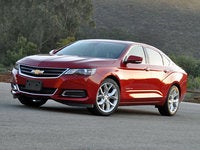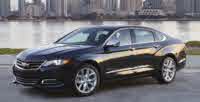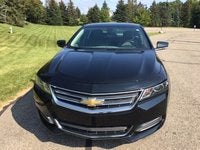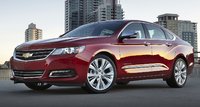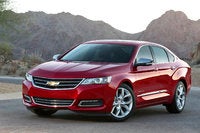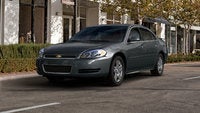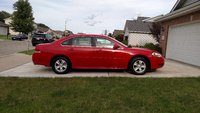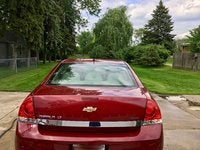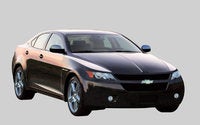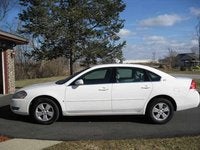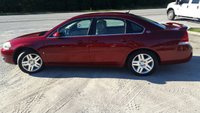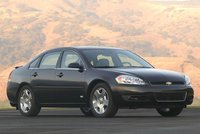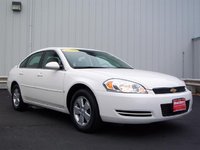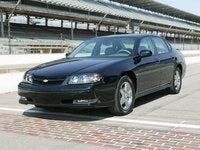Chevrolet Impala Model Overview
About the Chevrolet Impala
Available Now
For more than 50 years, the Chevrolet Impala has roamed the streets and byways of America and the world. An iconic car emerging from the late 1950s, complete with tailfins and a rear deck longer than a football field, the Impala has morphed through several significant styling changes over the decades, and still occupies an important part of Chevy's lineup.
The current Impala remains a full-size, front-wheel-drive sedan and delivers an expansive cabin, impressive fuel economy, the versatility of FlexFuel capability, and peace of mind, in the form of a safety package that includes standard OnStar services. For 2011, the Impala comes in entry-level LS, mid-level LT, and top-of-the-line LTZ trims. Chevy added a new optional Luxury package for the LT trim, which includes heated front seats, a six-way power-adjustable passenger seat, heated power mirrors, and an automatic rearview mirror. Other than that, the Impala remains unchanged for 2011.
Chevy offers the Impala with a choice of two engines. A 211-hp, 3.5-liter V6 powers the Impala LS and LT trims, while the LTZ retains its 233-hp, 3.9-liter V6. Both FlexFuel-capable engines run on regular gasoline as well as E85 fuel. The smaller powerplant performs well around town but sometimes struggles when passing at highway speeds. Fuel economy numbers check in at 18/29 mpg for the base V6 and 17/27 for the larger V6, although those numbers drop when the engines are running on E85 fuel.
Despite its positive points, the Impala has not scored well with reviewers, who find fault with the car's interior quality, dated mechanical equipment, spotty performance, and uninspiring exterior design. It bears little resemblance to the upscale and popular Impalas of the 1950s and '60s, reviewers note, and comes up short when compared to such competitors as the Ford Taurus, the Buick LaCrosse, the Hyundai Azera, and the Chrysler 300.
The Impala's current generation (its ninth) dates back to 2006, so a refresh is definitely overdue. The automaker has a good opportunity to improve the Impala in its next generation, which most observers expect in 2012, although some push it back as far as 2014. According to early rumors, the next-generation Impala will be taller but shorter than the current version, and will pull in elements of a crossover vehicle and perhaps even some SUV features. The goal will be to create a car that continues to appeal to current customers while attracting a wider range of prospective buyers.
Model History
The Impala has posted some pretty impressive numbers during its more than 50-year history. At one time during the early 1960s, the Impala was the best-selling car in America, despite its classification as a premium vehicle. This was due in part to Chevy's goal to keep the Impala affordable to typical middle-class buyers. As recently as 2008, the Impala was the best-selling domestic-built sedan in the U.S. and the sixth best-selling car in U.S. history.
Chevy certainly had high hopes for the Impala when it launched in 1958. Designed in part by GM styling legend Harley Earl, the first-generation Impala (originally known as the Chevrolet Bel Air Impala) had a long, low profile, a departure for Chevys of the era. Positioned at the top of Chevy's lineup of Bel Air coupes and convertibles, the Impala featured an all-new front-end design, a relatively short cabin, and a long rear deck, which gave it an elegant, stretched-out appearance. The muscular snout, prominent headlights, long tailfins, and signature triple taillights on either side helped make the Impala stand out in a crowd and ensured its future as a coveted collector car.
The first-generation Impala was available as either a hardtop Sport Coupe or a Convertible Coupe. Power came from a choice of three engines, including a 235-cubic-inch Blue Flame inline six-cylinder powerplant, a 283-cubic-inch Turbo Fire V8, and a 348-cubic-inch big-block Turbo Thrust V8, which put out about 315 hp. The Impala rode on a new chassis designed for minimal flexing and stability, although there were some safety concerns about the chassis in the event of an accident, according to some reports.
For its second generation, which came along fairly quickly in 1959, the Impala became longer (the wheelbase grew by 1.5 inches), wider (by 2 inches), and lower (by 3 inches). In addition, the Impala split off from the Bel Air line to become a separate model, and the trim lineup expanded to include a Four-Door Sedan and a Four-Door Hardtop Sport Sedan, as well as the Sport Coupe and Convertible. The Impala's brakes, suspension, and handling were also upgraded, although the powerplants remained the same.
By the time the third generation appeared in 1961, the Impala had become the best-selling car in America, and would remain so for the next decade, since it epitomized the perfect storm of performance, features, and affordability for car buyers in the early 1960s. The new Impala displayed a more subdued exterior as Chevy revamped all the sheet metal except for the roof. The triple taillights, which had disappeared for a year, returned, but the tailfins were gone, resulting in a sleeker rear end and nearly straight lines from front to rear. The big news for 1961, however, was the introduction of the Impala SS (Super Sport) package, the forerunner of the muscle cars of the mid- to late '60s. Owners could add the SS package to any Impala trim, outfitting it with an upgraded suspension, high-performance brakes and tires, and a choice of several powerful V8 engines, including a new Turbo-Fire 409-cubic-inch V8, which generated an impressive 360 hp. The Beach Boys immortalized the 409 in their song of the same name, which appeared on their debut album in 1962.
Chevy continued to refine and retune the Impala SS, and particularly the 409 trims, through the early '60s, and split the Impala SS off into its own line in 1964. It featured unique trim, side moldings, wheel covers, and badging.
The Impala's sleek, clean exterior lines continued into the fourth generation, which appeared in showrooms in 1965. The revamped Impala proved so popular it sold more than 1 million units that year, setting an industry record that stands to this day. The Impala sat on a new chassis and featured a pillarless side profile with vent windows at the front. In addition, Chevy introduced a new Impala Caprice four-door hardtop sedan trim with unique upholstery and wood-grain interior accents. Chevy phased out the 409 V8, replacing it with a new Mark IV 396 V8, which mated to a new Turbo Hydra-matic 350 automatic transmission.
Throughout the 1960s, the Impala and Impala SS continued to sell well. However, sales of the SS began to decline in the late '60s, and it was wrapped back into the Impala line as a packaged add-on. By 1969, the SS was dropped completely except for one trim, the Impala SS 427. By the time the fifth-generation Impala debuted in 1971, however, more significant changes were in the air. Although the Impala had sold more than 10 million units by 1972, the oil crisis of 1973 marked the death knell for the land boats and muscle cars of the 1950s and '60s, and the Impala began to downsize. It remained highly popular, however, becoming the best-selling car again in 1973.
By 1972, the Impala had stretched to an overall length of 219.9 inches, but by the time the sixth generation debuted in 1977, it had shed more than 10 inches off its length, as well as 4 inches off its width. It also dropped more than 700 pounds from its weight. The big-block V8s were gone as well. However, buyers and the industry seemed to like the changes, and the Impala was named Motor Trend Car of the Year in 1977.
The Impala continued to soldier on into the 1980s, as sales of full-size cars dropped dramatically. Chevy improved the Impala's aerodynamics and introduced a new 229-cubic-inch V6, which managed fuel economy numbers of 18/26 mpg, a new efficiency milestone for Chevy. Trims were reduced to a four-door sedan and a station wagon by 1982, as the popularity of sport sedans waned. By 1985, however, sales for the Impala proved so poor it was dropped from the lineup, although the Chevy Caprice continued into the '90s.
In 1994, the Impala re-emerged for its seventh generation as the Impala SS. Essentially a revised Caprice, it sat 2 inches lower than the base Caprice and came equipped with sport-oriented features typically reserved for police fleet cars, including a sport-tuned suspension, larger brakes, dual exhaust pipes, and a limited-slip differential. Power came from a 260-hp, 5.7-liter LT1 V8 borrowed from the Corvette and Camaro, with some minor retuning. Design-wise, the Impala SS drew some styling cues from the muscle cars of the '60s, with a more rounded shape, a body-colored grille, rocker moldings, and a rear spoiler. It was available only in black, and continued until 1996, when Chevy again dropped it from the lineup, along with the Caprice, the Buick Roadmaster, and the Cadillac Fleetwood, as GM cleared its assembly lines to make way for the coming SUV wave.
The Impala was down but not out, as it was set to re-emerge yet again, in 2000, as the eighth generation, with a return to its core values of the early 1960s. In re-designing the car, Chevy again attempted to create that perfect storm of performance, features, and affordability. The four-door Impala sedan sat on a platform borrowed from the now-defunct Lumina, which it replaced in the automaker's lineup, and came in Base and LS trim levels. While all previous Impalas had been rear-wheel drive, the new Impala was a front-wheel-drive vehicle. Power came from either a 180-hp, 3.4-liter V6 or a 200-hp, 3.8-liter V6. Outside, the new Impala took a more conservative approach, with rounded, contemporary lines, although the rounded taillights brought back some of the old Impala's mystique.
In 2002, Chevy introduced an LS Sport appearance package, which included a front bumper extension, a chrome-finished exhaust pipe, and a unique six-gauge instrument cluster. In 2004, Chevy debuted a new 240-hp, 3.8-liter supercharged V6 powerplant, which drove the Impala from 0-60 in 6.5 seconds, returning some of the sports car feel to the long-running brand.
The ninth and current generation Impala appeared in showrooms with the 2006 model year. It came in LS, LT, and LTZ trims, as well as an SS trim, powered by a new 303-hp, 5.3-liter V8, which drove the Impala from 0-60 in 5.6 seconds. The base powerplant for the Impala was a 211-hp, 3.5-liter V6. Inside the spacious cabin, the Impala sported an all-new interior with wood-grain trim, chrome accents, and revised control knobs. Owners of LS and LT trims could add six-passenger bench seating as an option, while the LTZ came equipped with leather upholstery.
In 2007, Chevy added a FlexFuel-capable 233-hp, 3.9-liter V6 engine with Active Fuel Management, while the SS came equipped with XM satellite radio as well as standard leather-appointed upholstery. For it's 50th anniversary in 2008, Chevy unveiled a 50th Anniversary Edition Impala, which featured leather-trimmed seats with a 50th-anniversary logo, leather-wrapped steering wheel with contrast stitching, a sport suspension, a rear SS-style spoiler, and 18-inch SS-style alloy wheels. In 2010, Chevy dropped the SS trim from the Impala lineup. More than likely, though, given its history, we'll be seeing it again at some point in the future.
Used Versions
With millions of Impalas sold over the past few decades, prospective buyers have a lot of options, from the collector cars of the late 1950s and early '60s to the sportier versions of the late '60s and '70s, to the revamped and short-lived Chevy Impala SS of the mid-90s, to the current 21st century generation. In particular, buyers seeking a full-size, front-wheel-drive family sedan with plenty of safety features should look at late-model Impalas, especially those of the ninth generation, built after 2006.
Late-model Impalas have held their value fairly well, according to Kelley Blue Book. In fact, the Impala has held its value better than comparable cars from Ford and Chrysler. However, with the current generation nearing its end and a new Impala likely on the horizon, prospective buyers can probably find some good deals on the Impala. Chevy recalled Impalas built in 2009 and 2010 due to issues with the seat belts, so be sure to check if that feature has been fixed on any late-model Impala you're considering.
Owners on a budget might want to look at the eighth-generation Impala, produced from 2000 to 2005. Essentially the same size as the current generation, its front-wheel-drive configuration emphasizes handling over performance, but it will meet the needs of most families who require plenty of interior space.
The SS Impalas of the mid-'90s have also held their value well, according to some owners. Prized by those who value performance, the sport-oriented SS delivered plenty of power under the pedal, thanks to its big V8 engine, and its sport suspension ensured nimble handling.
Generally, the Impala has had good reliability ratings, and even older versions can make good buys, despite their high mileage. But it's the muscle-car Impalas of the 1960s and the tailfinned versions of the late '50s that have become particularly popular with collectors, many of whom are willing to purchase the cars at premium prices.
Used Chevrolet Impala
Chevrolet Impala Questions
2002 Chevy Impala LS Where Is The Vapor Canister And Purge Solenoid?
Car won't take gas
Slow 2018 Sedan That Did Quarter Mile Track
what is the slowest 2018 sedan in 2018
Stabilitrak / Traction Control / ABS
I had just had a new right back strut replaced, new emergency brake assembly replaced and all four rotors, and brakes replaced at an auto shop for my 2012 Chevy Impala. now my dash keeps flashing ...
Ac Fan Not Blowing As Strong As Normal
2020 impala my ac works fine for about 30 minutes then after barely blows any air out. Still gets cold and hot just fine the fan just gets much weaker.
